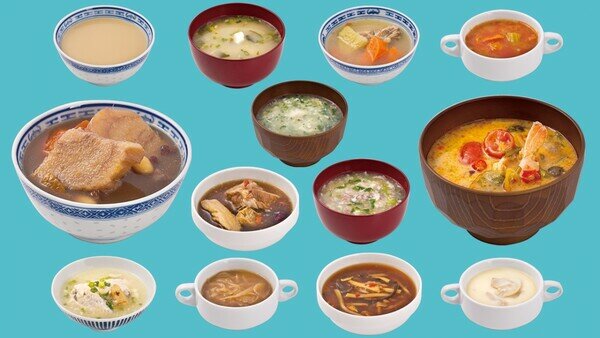Many people regard soup as part of healthy, nourishing diet and believe that having more soup benefits health. However, test findings of a joint study conducted by the Consumer Council and the Centre for Food Safety (CFS) on 130 soup samples showed that, on average, sodium content of a bowl of soup accounted for 36% of the daily limit of sodium intake recommended by the WHO.
For those prefer savoury soups, special attention must be paid on sodium intake. In 1 Tom Yum soup sample tested, sodium content of 1 bowl has already gone beyond the recommended daily limit. Sodium content of the seemingly "less salty" Chinese soups cannot be overlooked either. In 1 pork soup with green radish and carrot sample, consuming 2.5 bowls would exceed the recommended daily limit of sodium intake.
The test, aimed to investigate sodium content in selected types of soups, covered 130 soup samples of 13 categories commonly available in local restaurants and retail outlets, including also 5 samples of pre-packaged soup.
Findings showed that on average, 1 bowl (240g) of soup contained approximately 720mg of sodium, representing 36% of the recommended daily limit. For soup lovers, drinking just 2.5 bowls (600g) per day would mean 1,800mg of sodium, which equivalent to 90% of the recommended daily limit.
Among the 13 categories of soups tested, Tom Yum soup on average had the highest sodium content, with each bowl containing approximately 1,270mg, or 63% of the recommended daily limit. For the Tom Yum soup sample with the highest sodium content, each bowl contained 2,016mg of sodium, exceeded the recommended daily limit already.
Among the 10 Tom Yum soup samples, the lowest sodium content was 888mg per bowl, 1,128mg less than the highest sodium content sample. This shows that sodium content of the same type of soup can vary significantly. There is clearly room for the food industry to reduce sodium content in soups by using recipes with less salt to provide consumers with healthier choices.
Closely following Tom Yum soup in high sodium content were Borsch, hot and sour soup, and miso soup, which had an average of 955mg, 912mg and 866mg of sodium per bowl, respectively. Consume a bowl of Borsch at lunch and a bowl of hot and sour soup at dinner, the average sodium intake from soup alone would be over 1,800mg. Along with the sodium takes in from other food, it is very likely to exceed the recommended daily limit (2,000mg sodium).
Many people believe that Chinese soups are healthier. Among the 13 categories tested, kudzu root soup was found to have the lowest sodium content on average. While the sample with the lowest sodium content had only 65mg per bowl, the highest one contained 528mg per bowl, i.e. over seven times higher than the lowest. Consuming a bowl of the latter would mean more than a quarter of the recommended daily limit of sodium intake.
Among the pork soups with green radish and carrot samples, 1 had sodium content of 792mg per bowl, 40% of the recommended daily limit. Consume about 2.5 bowls of this soup would reach the daily limit.
The soups available in retail outlets are mostly pre-packaged Chinese soups, with sodium content ranging from 158 to 230mg per 100g among 5 samples collected, and on average 185mg per pack. The Council suggests consumers read nutritional labels on the packages warily and at the same time, the volume of each pre-packaged soup is different, consumers are suggested to pay attention to the portion size to avoid excessive intake of sodium from consuming soups.
For adult population in Hong Kong, soup is the second largest contributor of daily dietary sodium intake, after sauces and condiments. Excessive intake of sodium may cause many health problems, such as higher risks in high blood pressure, heart disease, stroke, and other chronic illnesses.
The Council shared test reports on sodium content with the restaurants surveyed. Some stated that they will consider reducing sodium content or use alternative ingredients as flavour enhancers. However, a few others reverted with concerns that if the soup is less savoury, they might lose customers and businesses. The Council disagreed with these concerns and reminded restaurant operators that business prosperity should not be pursued at the expense of consumer's health.
The Council suggests restaurant operators to improve recipes, e.g. by using natural ingredients to enhance flavour, use low-sodium seasonings or adjust serving size to reduce the intake of sodium. On menu, price list and other printed materials, information such as nutritional content of each dish and the recommended portion should be provided for consumer' easy selection.
Consumers who wish to adopt a low-sodium diet can refer to below recommendations:
- The sodium content in soups differs significantly among restaurants, when the soup is too salty when dining out, reduce portion and reflect to the operator;
- When ordering soup, pay attention to the serving portion. If it is too big, either share with others or pack some to take away;
- When preparing your own soup, use an appropriate amount of salt or use no salt at all. Rely on the natural flavours of the ingredients as seasoning;
- Maintain a balanced and diversified diet. Reduce consumption of food with high sodium content, such as processed foods.
The Consumer Council reserves all its right (including copyright) in respect of CHOICE magazine and Online CHOICE.



